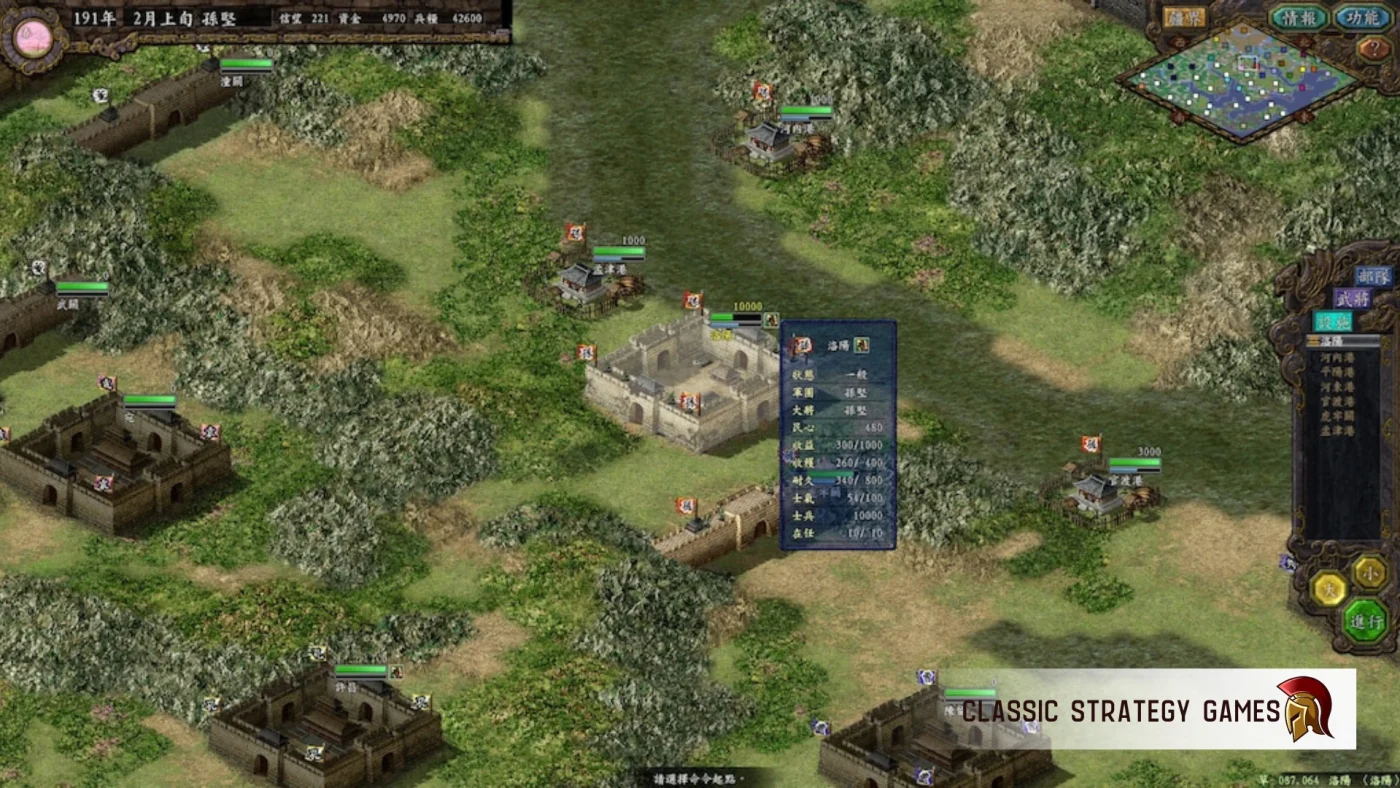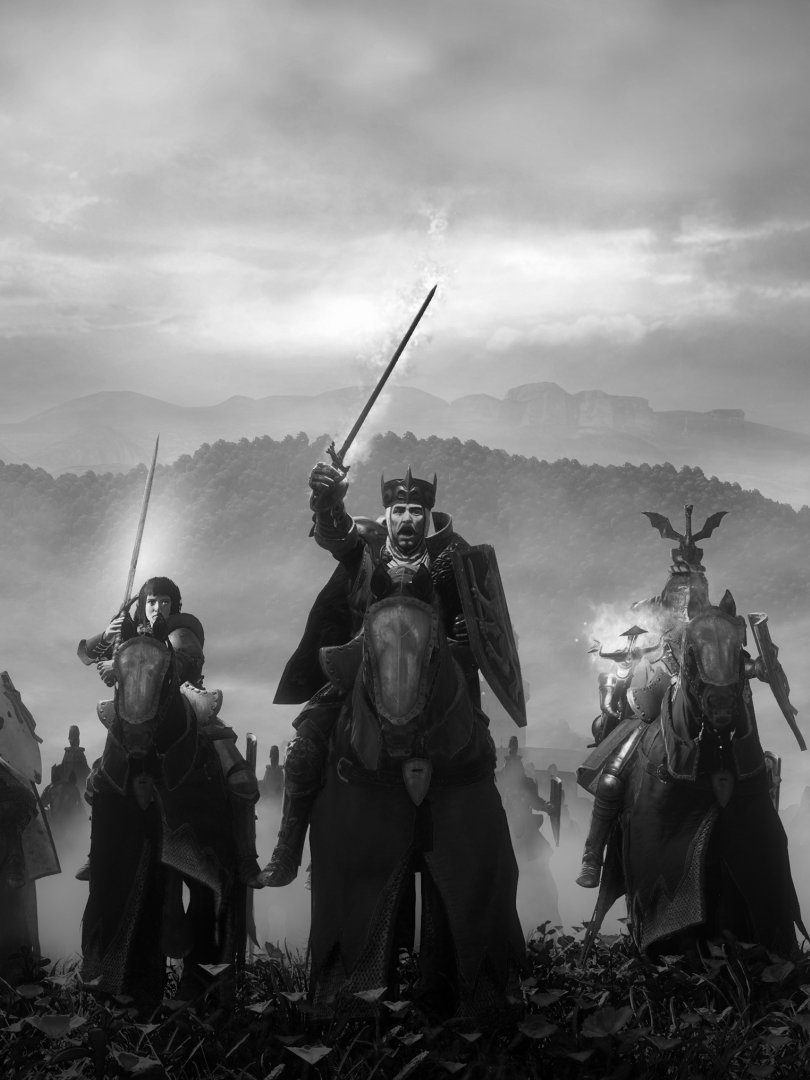By the time Romance of the Three Kingdoms IX launched in 2003, Koei had already spent nearly two decades refining its approach to grand strategy set during China’s turbulent Three Kingdoms period. The series had evolved significantly since its debut in 1985, and RTK IX marked a bold shift in mechanics, moving away from character-driven micromanagement toward a fully strategic, empire-wide approach.
This instalment introduced a unified map where actions played out in real time, departing from the city-based structure of its predecessors. Instead of managing individual officers on a per-city basis, players had direct control over their entire domain, coordinating military campaigns, diplomacy, and economic development across China in a more fluid and dynamic system. The result was a game that emphasized large-scale strategic thinking while retaining the deep political, military, and resource management layers that made the series a staple of historical strategy.
A Unified Map and a New Approach to Warfare
One of the defining features of Romance of the Three Kingdoms IX was its single-map approach. Previous titles in the series operated on a city-based system where players issued orders for each controlled city separately. Here, Koei removed that barrier, making China a continuous, living battlefield. Troop movements, supply lines, and economic planning all played out in real-time across the entire map, with no segmented city screens to navigate.
This change made military campaigns feel more organic. Armies moved across the land as visible forces rather than being abstracted within cities. This encouraged strategic manoeuvring – cutting off enemy supply lines, securing natural chokepoints, and responding quickly to threats. Wars weren’t just a matter of amassing forces in a city and deploying them all at once; players had to consider geography, logistics, and timing.
Cities still functioned as the economic backbone of a kingdom, producing resources, training troops, and developing commerce. However, the game shifted emphasis toward governing from a macro perspective rather than micromanaging individual officers. Governors could be appointed to oversee cities, handling internal affairs while players focused on grand strategy.
Officer Management and Personality-Driven Diplomacy
Though RTK IX streamlined city management, it didn’t abandon the deep character interactions that defined the series. With over 700 officers, each with unique stats, abilities, and historical relationships, the game still felt personal.
Officers played key roles in military, political, and economic success. They could be assigned as generals to lead armies, administrators to oversee cities, or diplomats to forge alliances. Their effectiveness depended on their attributes – an intelligent strategist like Zhuge Liang excelled at planning and countering enemy moves, while a warrior like Lu Bu dominated the battlefield but was an unpredictable ally.
Diplomacy was still deeply rooted in historical relationships. Some officers naturally disliked each other due to past betrayals, while others had strong bonds of loyalty. Recruiting enemy officers required careful negotiation, gifts, or, in some cases, military coercion. Those with high loyalty were almost impossible to turn, but weaker-willed officers could be persuaded if given the right incentives.
The game’s political system allowed for strategic alliances, though they were often temporary. Rulers could negotiate ceasefires, trade resources, or demand vassalization, but betrayals were common. A powerful ally could suddenly turn into an enemy, and managing relationships was just as important as managing armies.
Military Strategy and Tactical Combat
Combat in RTK IX remained turn-based but played out in real time on the unified map. Unlike earlier games, where battles took place on separate grids, armies fought dynamically as they moved across China. This meant that positioning, terrain, and unit composition played a larger role than ever before.
Troops required supplies, and campaigns had to be carefully planned. Marching too far from a controlled city without securing supply lines led to starvation and weakened forces. Sieging cities took time, and attacking an entrenched enemy without proper siege weapons was often disastrous. Armies could also be ambushed, reinforcing the importance of scouting and intelligence gathering.
The game introduced a new feature called “Tactics,” allowing officers to use unique abilities that could turn the tide of battle. These tactics, which ranged from ambushes to fire attacks, could be devastating when used correctly. However, their effectiveness depended on officer skills and terrain conditions. Battles weren’t simply about numbers – strategy and officer selection played a crucial role in determining victory.
Naval combat was also improved, with battles taking place on rivers and coastlines. Controlling key waterways provided strategic advantages, allowing for faster troop movement and economic benefits.
The Role of Economy and Infrastructure
War alone wasn’t enough to succeed in RTK IX. A strong economy was vital for sustaining military campaigns. Cities needed to produce food, train soldiers, and invest in commerce to generate income. Players had to balance taxation and public order – over-taxing citizens could lead to rebellions, while neglecting economic development resulted in stagnation.
Infrastructure projects such as roads and irrigation improved trade and agriculture, making cities more productive. Controlling rich farmlands ensured food security, while capturing trade hubs increased gold reserves. These economic factors influenced military capacity, as well-fed and well-paid troops performed better than armies struggling with supply shortages.
Event-Driven Storytelling and Historical Flavor
While RTK IX provided an open-ended sandbox, historical events still played a major role. Key moments from Romance of the Three Kingdoms triggered special events that could alter the course of the game. The fall of the Han Dynasty, the rise of Cao Cao, and the formation of the Three Kingdoms all had potential to shift the balance of power.
Some rulers had unique advantages based on their historical significance. Cao Cao, known for his cunning and strategic mind, had access to powerful officers and a strong starting position. Liu Bei, despite weaker initial resources, had the ability to recruit some of the most legendary figures of the era. Players could follow historical paths or carve out entirely new destinies, allowing for massive replayability.
Legacy and Reception
Romance of the Three Kingdoms IX was a divisive but ultimately influential entry in the series. Some long-time fans missed the deeper character micromanagement of previous titles, while others praised the streamlined empire-wide approach. The real-time campaign map was a bold innovation that prefigured future strategy games, including later Total War entries.
The game’s AI was more aggressive than in previous instalments, making diplomacy and military planning more dynamic. However, it wasn’t without flaws – certain factions had a tendency to collapse too easily if they lost a key battle, sometimes leading to unbalanced campaigns.
Despite these issues, RTK IX remains a standout for those who prefer large-scale strategic planning over character-focused management. Its real-time movement system, unified map, and deeper emphasis on logistics made it one of the more complex and rewarding entries in the series.
Why It Still Matters
Even two decades later, Romance of the Three Kingdoms IX holds up as a deep and challenging grand strategy game. It abandoned many of the series’ traditional micromanagement mechanics in favour of a larger, empire-spanning focus, making it one of the most unique entries in the franchise. The shift to a unified map and real-time troop movement brought a new level of strategic depth, paving the way for future innovations in the genre.
For those who love Total War, Crusader Kings, or any strategy game that blends politics with military conquest, RTK IX offers a rich, rewarding experience. It demands long-term planning, careful resource management, and an ability to adapt to both the chaos of war and the complexities of diplomacy. While later games in the series refined some of its ideas, RTK IX remains a high point for players who enjoy the challenge of managing an entire kingdom rather than just a single city or officer.
It was a bold experiment in grand strategy, and even now, its influence can be felt in how modern games handle empire-wide decision-making.


